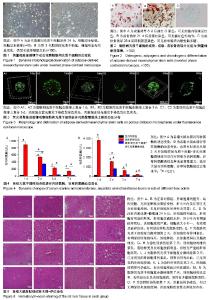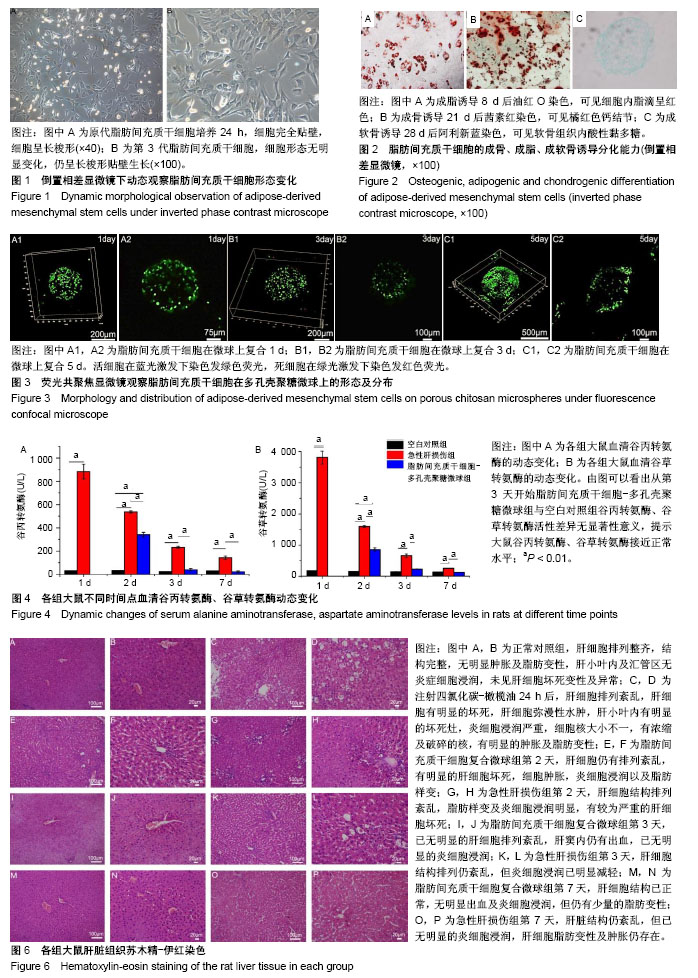| [1] Bernal W, Wendon J. Acute liver failure. N Engl J Med. 2013;369(26): 2525-2534.[2] Kadota Y, Yagi H, Inomata K, et al. Mesenchymal stem cells support hepatocyte function in engineered liver grafts. Organogenesis. 2014;10(2):268-277.[3] An SY, Han J, Lim HJ, et al. Valproic acid promotes differentiation of hepatocyte-like cells from whole human umbilical cord-derived mesenchymal stem cells. Tissue Cell. 2014;46(2):127-135.[4] Ortiz LA, Dutreil M, Fattman C, et al. Interleukin 1 receptor antagonist mediates the antiinflammatory and antifibrotic effect of mesenchymal stem cells during lung injury. Proc Natl Acad Sci U S A. 2007;104(26): 11002-11007.[5] Gilsanz C, Aller MA, Fuentes-Julian S, et al. Adipose-derived mesenchymal stem cells slow disease progression of acute-on-chronic liver failure. Biomed Pharmacother. 2017;91:776-787.[6] Nicolas CT, Wang Y, Nyberg SL. Cell therapy in chronic liver disease. Curr Opin Gastroenterol. 2016;32(3):189-194.[7] Xu L, Wang S, Sui X, et al. Mesenchymal Stem Cell-Seeded Regenerated Silk Fibroin Complex Matrices for Liver Regeneration in an Animal Model of Acute Liver Failure. ACS Appl Mater Interfaces. 2017;9(17):14716-14723.[8] Wiebe J, Nef HM, Hamm CW. Current status of bioresorbable scaffolds in the treatment of coronary artery disease. J Am Coll Cardiol. 2014;64(23):2541-2551.[9] Malcor JD, Juskaite V, Gavriilidou D, et al. Coupling of a specific photoreactive triple-helical peptide to crosslinked collagen films restores binding and activation of DDR2 and VWF. Biomaterials. 2018;182:21-34.[10] Subbarayan R, Girija DM, Rao SR. Human umbilical cord tissue stem cells and neuronal lineages in an injectable caffeic acid-bioconjugated gelatin hydrogel for transplantation. J Cell Physiol. 2018 Aug 24. doi: 10.1002/jcp.26834. [Epub ahead of print][11] Liu L, You Z, Yu H, et al. Mechanotransduction-modulated fibrotic microniches reveal the contribution of angiogenesis in liver fibrosis. Nat Mater. 2017;16(12):1252-1261.[12] Etter JN, Karasinski M, Ware J, et al. Dual-crosslinked homogeneous alginate microspheres for mesenchymal stem cell encapsulation. J Mater Sci Mater Med. 2018;29(9):143.[13] Chander V, Singh AK, Gangenahalli G. Cell encapsulation potential of chitosan-alginate electrostatic complex in preventing natural killer and CD8+ cell-mediated cytotoxicity: an in vitro experimental study. J Microencapsul. 2018:1-27.[14] Wang Y, Yuan X, Yu K, et al. Fabrication of nanofibrous microcarriers mimicking extracellular matrix for functional microtissue formation and cartilage regeneration. Biomaterials. 2018;171:118-132.[15] Friedenstein AJ, Chailakhjan RK, Lalykina KS. The development of fibroblast colonies in monolayer cultures of guinea-pig bone marrow and spleen cells. Cell Tissue Kinet. 1970;3(4):393-403.[16] Fan CG, Tang FW, Zhang QJ, et al. Characterization and neural differentiation of fetal lung mesenchymal stem cells. Cell Transplant. 2005;14(5):311-321.[17] Caplan AI, Correa D. The MSC: an injury drugstore. Cell Stem Cell. 2011;9(1):11-15.[18] Manuguerra-Gagné R, Boulos PR, Ammar A, et al. Transplantation of mesenchymal stem cells promotes tissue regeneration in a glaucoma model through laser-induced paracrine factor secretion and progenitor cell recruitment. Stem Cells. 2013;31(6):1136-1148.[19] Guo DB, Zhu XQ, Li QQ, et al. Efficacy and mechanisms underlying the effects of allogeneic umbilical cord mesenchymal stem cell transplantation on acute radiation injury in tree shrews. Cytotechnology. 2018 Jul 31. doi: 10.1007/s10616-018-0239-z. [Epub ahead of print][20] Chang SH, Huang HH, Kang PL, et al. In vitro and in vivo study of the application of volvox spheres to co-culture vehicles in liver tissue engineering. Acta Biomater. 2017;63:261-273.[21] Hoyer DP, Munteanu M, Canbay A, et al. Liver transplantation for acute liver failure: are there thresholds not to be crossed. Transpl Int. 2014; 27(6):625-633.[22] Pan XN, Zheng LQ, Lai XH. Bone marrow-derived mesenchymal stem cell therapy for decompensated liver cirrhosis: a meta-analysis. World J Gastroenterol. 2014;20(38):14051-14057.[23] Kumari S, Vermeulen S, van der Veer B, et al. Shaping Cell Fate: Influence of Topographical Substratum Properties on Embryonic Stem Cells. Tissue Eng Part B Rev. 2018;24(4):255-266.[24] Li Y, Hermanson DL, Moriarity BS, et al. Human iPSC-Derived Natural Killer Cells Engineered with Chimeric Antigen Receptors Enhance Anti-tumor Activity. Cell Stem Cell. 2018;23(2):181-192.e5.[25] Fujita Y, Kawamoto A. Stem cell-based peripheral vascular regeneration. Adv Drug Deliv Rev. 2017;120:25-40.[26] Perico L, Morigi M, Rota C, et al. Human mesenchymal stromal cells transplanted into mice stimulate renal tubular cells and enhance mitochondrial function. Nat Commun. 2017;8(1):983.[27] Soliman MG, Mansour HA, Hassan WA, et al. Mesenchymal stem cells therapeutic potential alleviate lipopolysaccharide-induced acute lung injury in rat model. J Biochem Mol Toxicol. 2018:e22217. doi: 10.1002/jbt.22217. [Epub ahead of print][28] Jiang W, Tan Y, Cai M, et al. Human Umbilical Cord MSC-Derived Exosomes Suppress the Development of CCl4-Induced Liver Injury through Antioxidant Effect. Stem Cells Int. 2018;2018:6079642.[29] Zuk PA, Zhu M, Mizuno H, et al. Multilineage cells from human adipose tissue: implications for cell-based therapies. Tissue Eng. 2001;7(2): 211-228.[30] Padalhin AR, Lee BT. Hemostasis and Bone Regeneration Using Chitosan/Gelatin-BCP Bi-layer Composite Material. ASAIO J. 2018 Aug 25. doi: 10.1097/MAT.0000000000000850. [Epub ahead of print][31] Shi D, Zhang J, Zhou Q, et al. Quantitative evaluation of human bone mesenchymal stem cells rescuing fulminant hepatic failure in pigs. Gut. 2017;66(5):955-964. |



